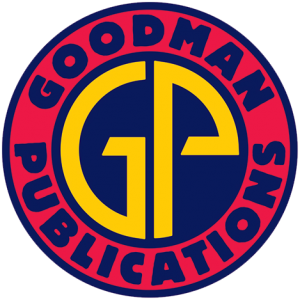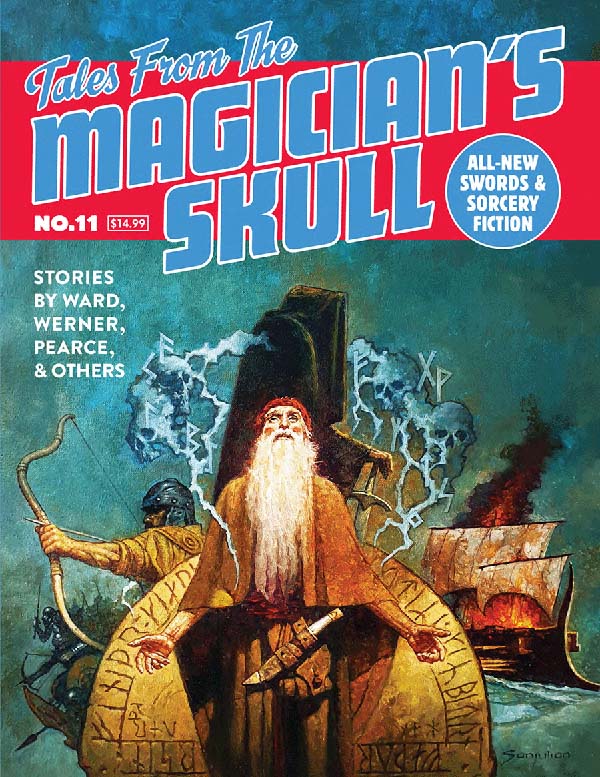
Our Appendix N Archeology and Adventures in Fiction series are meant to take a look at the writers and creators behind the genre(s) that helped to forge not only our favorite hobby but our lives. We invite you to explore the entirety of the series on our Adventures In Fiction home page.
Happy Birthday to Michael Moorcock, a Big Writer with Big Ideas
by Terry Olson
“I think of myself as a bad writer with big ideas, but I’d rather be that than a big writer with bad ideas—or ideas that have gone bad.”
– Michael Moorcock, 1963
On the 18th of December, we celebrate the birthday of Michael Moorcock—a big writer with big ideas (regardless of what he thought a handful of decades ago). It’s difficult to rank Moorcock’s diverse achievements in terms of importance or influence. He’s impacted gaming through his Elric stories, he’s been a prolific writer of the Eternal Champion and Multiverse themes, he’s been an influential editor that helped change (dare I say, “improve”) the face of Science Fiction, he’s written comics, and he’s written lyrics for and performed with major rock bands! Perhaps most important of all, he’s inspired generations of great writers, such as Alan Moore, Neil Gaiman, and Thomas Pynchon.
Michael Moorcock is one of my favorite authors, not just one of my “favorite Appendix N” authors. His imagery and themes are so inspiring that I refer to them again and again. In the 2014 DCC Free RPG Day adventure, Elzemon and the Blood-Drinking Box (reprinted in Chaos Rising), I wrote of a long spiral stairway descending around a seemingly bottomless shaft for hours (actually days) in darkness; the idea was to make PCs question whether they were making any progress at all. This was inspired by a passage in the Elric story “While the Gods Laugh”:
“For several hours they pressed onwards in pitch darkness, clinging to one another as they reeled forward, uncertain of their footing and still aware that they were moving down a gradual incline. They lost all sense of time and Elric began to feel as if he were living through a dream. Events seemed to have become so unpredictable and beyond his control that he could no longer cope with thinking about them in ordinary terms. The tunnel was long and dark and wide and cold. It offered no comfort and the floor eventually became the only thing which had any reality. It was firmly beneath his feet. He began to feel that possibly he was not moving—that the floor, after all, was moving and he was remaining stationary. His companions clung to him but he was not aware of them. He was lost and his brain was numb. Sometimes he swayed and felt that he was on the edge of a precipice.”
In Escape from the Shrouded Fen, I adapted Elric’s battle (also in “While the Gods Laugh”) against the Mist Giant, Bellbane, for part of the backstory. And, in 2018’s DCC Free RPG Day adventure, Man-bait for the Soul Stealer, I gave a nod to Stormbringer by writing in a sword that is a soul-storing phylactery. Moorcock is one of my initial starting places if I’m looking for something to jar my brain out of a rut. For more Elric discussion, check out the Appendix N Podcast’s episode 36 devoted to Stormbringer, for which I was a guest.
Many, like me, discovered Michael Moorcock through Gary Gygax’s Appendix N (in AD&D’s Dungeon Master’s Guide); he is the last living author of Appendix N, by the way. Gygax lists Moorcock’s first two published Elric collections The Stealer of Souls and Stormbringer, which span 1961 to 1964. Despite this being the tip of his literary iceberg, Moorcock crammed so much into these two works that OD&D, AD&D, DCC RPG, and even D&D 5E reference them (read “Appendix N Archaeology: Zenith the Albino” for more information). Chaosium and Mongoose published RPG lines based on the albino and his mythos. Although Elric of of Melniboné and his soul-stealing blade Stormbringer are among Moorcock’s most popular and well-known creations, they are only a fraction of his literary contributions.
Moorcock’s oeuvre as an author of fiction is vast, with some 70 novels and 160 short stories too numerous to discuss in detail. He’s received many honors and awards, having been inducted into the Science Fiction and Fantasy Hall of Fame, named a Grand Master of the Science Fiction and Fantasy Writers of America, and bestowed various life achievement awards. Interestingly, almost all of the awards he’s received for particular works (Nebula, August Derleth Fantasy Awards, World Fantasy Awards, etc.) are for stories that do not feature Elric. The exception is the 1974 British Fantasy Award for Best Short Story for The Jade Man’s Eyes. Nonetheless, there are common threads between the Elric stories and most of Moorcock’s other work.
The Eternal Champion is a theme prevalent in much of Moorcock’s writing. As one reads the post-1964 Elric stories, such as The Vanishing Tower and The Sailor on the Seas of Fate, they are introduced to Corum Jhaelen Irsei, Erekosë, and Dorian Hawkmoon. Each of these has their own series of stories and, in addition to Elric, is an incarnation or aspect of the same being, The Eternal Champion. This hero fights for the cosmic balance between Law and Chaos in his own universe, while other incarnations wage the same war in parallel universes in the past, present, or future. Some aspects of the Eternal Champion are called by Fate to the same time and location to fuse into a super-being to defeat an otherwise indestructible cosmic imbalance, but this is a rare occurrence. More often a champion endures their trials without the help of another of their aspects. Moorcock has written about many (roughly forty) different incarnations of this hero.
Moorcock calls this idea of multiple parallel universes the “multiverse.” The idea that aspects of the same person can exist in alternate realities is not as far-fetched as one might think. Indeed, there are interpretations of quantum mechanics that suggest that each possible alternative history and future represents a separate universe. The contention is that if you will choose to walk your dog today, there’s a universe in which you will not. This concept is still controversial in the cosmological community, but look up “many-worlds interpretation”, “parallel universes”, and “multiverse” for more information. Michael Moorcock has claimed that he coined the term multiverse to represent this concept; this might be true. However, it’s worth noting that the word was used by William James in 1895 (albeit with a different meaning), and the concept was in existence before Moorcock wrote about it. Regardless, his employment of the multiverse idea, along with the Eternal Champion fighting the eternal struggle between Law and Chaos, are key contributions of his literary influence. For a DCC-specific example, check out Mercurial Magic result 80, “Dimensional schism,” on p. 114 of the core rulebook.
Watch Moorcock discuss both the Multiverse and the Eternal Champion in this short video from Tor Books.
Michael Moorcock also made significant literary contributions as an editor. From 1964 to 1971, Moorcock was the editor for New Worlds magazine and is credited with beginning and fostering the “New Wave” of science fiction. In The Detached Retina: Aspects of SF and Fantasy, Brian Wilson Aldiss writes, “Mike Moorcock kicked out the old gang and installed the new. Galactic wars went out; drugs came in; there were fewer encounters with aliens, more in the bedroom. Experimentation in prose styles became one of the orders of the day…The revolution was inevitable…Life was where New Worlds was.” This movement is credited with cross-pollenating mainstream and science fiction motifs using “outside” stylistic innovations to raise the standards of the genre, thus making it more difficult to proliferate pulp-style dialog/characterizations with an overemphasis of jargon and technical accuracy. Moreover, the New Wave movement increased the number of women reading and writing science fiction, such as Ursula K. Le Guin. Appendix N aficionados should note that J. G. Ballard and Roger Zelazny are also associated with the movement.
Another significant editorial position held by Moorcock was in 1959, when he was 19 years old. During this time he edited Sexton Blake Library and was exposed to Anthony Skene’s villain, Zenith the Albino, which would be Moorcock’s primary inspiration for his own albino, Elric (read Appendix N Archaeology: Zenith the Albino for more information). It’s frightening to imagine a present in which this editing job is absent in Moorcock’s past.
In addition to writing fiction and editing, Moorcock has written numerous essays of critical analysis about Fantasy and Science Fiction. In May 1961, Moorcock wrote an essay for Amra, “Putting a tag on it,” in which he desired “another general name to include the sub-genre of books which deal with Middle Earths and lands and worlds based on this planet, worlds which exist only in some author’s vivid imagination.” He coined the term “Epic Fantasy” for the quest stories of Howard, Leiber, Anderson, Tolkein, etc. Just one month earlier, Fritz Leiber had coined the term “sword-and-sorcery” in the April 6 issue of Ancalagon, and restated his position in the July 1961 issue of Amra, two months after Moorcock’s article. Leiber’s designation has had more staying power, but Moorcock still prefers his own (at least as recently as 2008). In 1963-64 Moorcock wrote a four-part series of articles in Science Fantasy called “Aspects of Fantasy” which discussed the genre’s literary roots and fundamental characteristics. 2004’s Wizardry and Wild Romance (MonkeyBrain Books) updates this series and is a more recent collection of essays and reviews. Moorcock’s critical essays are a treat to read, and display Moorcock as an extremely well-read analyst with carefully crafted arguments. He states his opinions strongly and his style suggests an invitation to debate. Here are a few samples which I provocatively take out of context to encourage reading the entire articles; bold-faced emphases are my own.
From “Aspects of Fantasy 4”: “Fantasy writers are often called writers of “adult fairy stories.” Most of them are not—they are writers of fairy stories for adults who still want to read fairy stories. There is nothing wrong in writing or reading fairy stories. There is something retarded, however, in the man who devotes himself wholly either to reading or to writing the stuff. The writer who merely recaptures the dream-worlds of childhood without adding to this what his adult mind has learned is an inadequate artist, if nothing else. He may be an inadequate artist and a good stylist, like Dunsany or Bradbury or Tolkien, but if, as in the case of these, he cannot do more than recapture the wonders and terrors of infancy, he deserves to be regarded as we regard an infant prodigy—with admiration but not too much serious attention.”
From “Aspects of Fantasy 1”: “Therefore one of the differences between fairy stories and the major proportion of adult fantasy stories is that an adult story rarely produces a comforting end. Whether the hero wins through or not, the reader is left with the suspicion or knowledge that all is not quiet on the supernatural front. For supernatural also read subconscious and you’re still with me.”
From “Epic Pooh” a 1978 article reprinted in Wizardry and Wild Romance: “The sort of prose most often identified with “high” fantasy is the prose of the nursery-room. It is a lullaby; it is meant to soothe and console. It is mouth-music. It is frequently enjoyed not for its tensions but for its lack of tensions. It coddles; it makes friends with you; it tells you comforting lies… The Lord of the Rings is much more deep-rooted in its infantilism than a good many of the more obviously juvenile books it influenced. It is Winnie-the-Pooh posing as an epic… I grew up in a world where Joyce was considered to be the best Anglophone writer of the 20th century. I happen to believe that Faulkner is better, while others would pick Conrad, say. Thomas Mann is an exemplary giant of moral, mythic fiction. But to introduce Tolkien’s fantasy into such a debate is a sad comment on our standards and our ambitions. Is it a sign of our dumber times that Lord of the Rings can replace Ulysses as the exemplary book of its century?”
Comics also contain significant contributions from Moorcock. In 1997 he wrote the 12-volume series Michael Moorcock’s Multiverse, which incorporates many of his characters and themes (some homework may be necessary to fully appreciate it). In 2004-2006 he released the 4-volume Elric: The Making of a Sorcerer. Both series were published by DC. Besides his own writing, numerous adaptations have been penned and inked throughout the years (hunt down P. Craig Russel’s Stormbringer if you can!). Even now, Titan Comics is re-releasing Elric, Corum, Erekosë, and Hawkwind comics as volumes in The Michael Moorcock Library, as well as newly-adapted Elric releases spear-headed by Julien Blondel. Regarding this latest release, Moorcock writes in the first volume, The Ruby Throne, “Julien Blondel, the writer, has given the story a few extra twists which, with my approval, have improved on my original narrative! This is not something I would normally accept but with a single exception: the story you begin reading here is the saga of the Albino I would have written myself if I had thought of it first!”
There is one more literary form, besides fantasy fiction, revolutionary editing, critical analysis, and comics, to which Michael Moorcock has contributed: lyrics. Moorcock has worked on both lyrical and musical concepts with the band Hawkwind, notably on the albums Warrior on the Edge of Time (based loosely on the Eternal Champion concept…and you can hear Moorcock do some vocals) and The Chronicle of the Black Sword. He’s also worked with the band Blue Oyster Cult, providing lyrics for the songs “Black Blade” on the album Cultosaurus Erectus and “Veteran of the Psychic Wars” on Fire of Unknown Origin. The latter was featured in the soundtrack to the animated cult-classic Heavy Metal. Moorcock also had his own band, The Deep Fix, where he played guitar, mandolin, and did vocals. Here are my favorites of Moorcock’s lyrics.
“Warriors” from Hawkwind’s Warrior on the Edge of Time
We are the warriors at the edge of time
We are Humanity’s scythe to sweep this way and that
And cut the Enemy down as weeds
We are Humanity’s spade to dig up the roots wherever they have grown
We are Humanity’s fire to burn the waste to the finest ash
We are the wind which will blow the ash away
As if it had never existed
We will destroy those Enemies
But we must first know the Enemies
And the Enemies are the devils who hide in our minds
And make us less than happy
They make us less than happy
We are the warriors at the edge of time
We are the veterans of a savage truth
We are the lost
We are the last
We are the betrayed
We are the betrayed
We are the betrayed…
“Veteran of the Psychic Wars” excerpt from Blue Oyster Cult’s Fire of Unknown Origin
You see me now, a veteran
Of a thousand psychic wars
I’ve been living on the edge so long
Where the winds of limbo roar
And I’m young enough to look at
And far too old to see
All the scars are on the inside…
I’m not sure that there’s anything left to me
And so, let us sing a “Happy Birthday” to Michael Moorcock, writer of epic fantasy, science fiction trendsetter, literary critic, rock star, and overall wellspring of inspiration. It need not be a Melnibonéan chorale sung by Doctor Jest’s tortured slaves. It need not be shrieked by the screaming statues of Hwamgaarl, Pan Tang’s capital. But it should be sung with respect and gratitude, though perhaps with a tiny bit of Elric’s insouciance.
But there’s more! Be sure to read our other great articles on the work of sword-and-sorcery’s very own Eternal Champion, and definitely don’t miss Sanctum Secorum’s recent hour long chat with Michael Moorcock, below:










